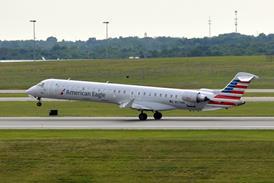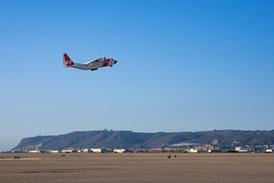GUY NORRIS / LOS ANGELES
Business is booming in the corporate aircraft sector with our 2001 census reiterating that the ascendancy of jet-powered business aircraft over turboprops is continuing apace
After almost a decade of promise in some cases, strong growth in new entry-level, super-light, mid-size and ultra-long range business jets, as well as new generation single turboprops, shows up among the trends in Flight International's 2001 corporate aircraft census.
Overall, the survey shows more than 11,100 jet-powered business aircraft and almost 8,800 turboprops in service. These latest figures do not include some government, military and para-military aircraft that were factored into past surveys, and therefore it represents the clearest picture yet of the true corporate growth trends. In common with previous years, the gradual increase of the jet fleet over the turboprop fleet continues, with the gap increasing year-on-year since jets claimed the ascendancy in 1997.
Making a mark at the upper end of the survey, in terms of size and capacity, are the growing fleets of Airbus A319CJ and Boeing Business Jets. Together they account for 61 aircraft, a 30% gain over last year, providing evidence of the success of this expensive new niche. The relative share of the corporate business, with BBJ accounting for 51 of the aircraft in this group, also reflects the overall split between Airbus and Boeing in terms of airliners that have been converted or adapted for corporate or executive use. In all, the census shows 31 non-ACJ Airbus aircraft in this role, versus 237 Boeing types. Later this year, the BBJ is expected to overtake the 727-100 as the most popular Boeing model in business aviation.
Against this background, the battle for market share between the two ultra-long- haul business jets - Bombardier's Global Express and Gulfstream's GV - continues unabated. Boosted by a substantial service entry lead, the GV fleet has leapt from 84 in 2000 to 132 this year, while the Global Express fleet had climbed steadily from 57 to 71 by July 2001. As with virtually every aircraft in the corporate survey, around 70% of both fleets are based in the USA.
Battle of the giants
In the "large" category, Gulfstream's GIVP, Bombardier's Challenger series, Cessna's Citation X, and Dassault's Falcon 900EX all enjoyed a buoyant period with the census showing fleet build-ups across the board. The GIVP fleet, for example, rose dramatically by more than 50 to 248, the vast bulk of the growth coming from the increase in popularity of the aircraft in North America.
The Falcon family's presence in the key Americas markets continued to increase with the presence of more 53 900EXs. Not surprisingly perhaps, the larger Falcons continue to dominate this market segment in Europe. The Challenger 604 build-up in Europe (to 31 from 23 in 2000) is also significant, but as usual the figures pale by comparison to the size of the North American fleet which now exceeds 140 with deliveries expected to push this towards 170 in the coming 12 months.
The high-speed Citation X fleet is closely following this trend in the super mid-size niche, with 147 of the current 163-strong fleet in service in North America. Attention is also being given to the changing fortunes of the Gulfstream G200, formerly the Galaxy, following its acquisition from IAI. The census currently shows this fleet unchanged from last year, hovering at 20, while Dassault's Falcon 2000 showed consistent growth over the period particularly in North America where the fleet grew by 24 to 104.
Among the fastest growers in the mid-range category are Bombardier's Learjet 60 and Raytheon's Hawker 800XP which between them now account for a staggering 472 aircraft in the census of which more than 350 are operated in North America. Sales of Cessna's competing Citation VII, which is now out of production, ended at 119 with attention now focused on the forthcoming Sovereign. Gulfstream's newly acquired G100, the former Astra SPX, meanwhile remains relatively static. The impact of the newly flown Bombardier Continental and Raytheon Hawker Horizon will not start to be felt on the census until 2003.
New boys on the block
Leading the rapidly expanding "super-light" niche are the popular Cessna Excel and Bombardier's Learjet 45. The fleet size of both doubled over from 2000 to 2001, representing one of the fastest build-ups in business aircraft history. The Excel fleet grew from 96 to 184, while the Learjet 45 jumped from 78 to 152 - the latter enjoying more sales success outside of its traditional North American stomping ground.
More big numbers are also seen in the "light" category which is dominated by Cessna's Citation Bravo, Encore and Ultra products, Bombardier's Learjet 31A and Raytheon's Beechjet 400A, the latter fleet having expanded to 319 from 276 in 2000.
Figuring fast as newcomers in the "entry-level" category are the rapidly growing fleets of CitationJet CJ1s and CJ2s, the former growing by 65 over the last year to 86, and latter having already reached 30 by the time of the census deadline. The competing Raytheon Premier 1 and Sino-Swearingen SJ30-2 have yet to register on the census, none having been delivered.
As many former turboprop owners and users switch to the similarly priced entry-level business jets, the impact is expected to fall most heavily on Raytheon's popular King Air - one of the last major turboprop series to remain in production. Future success is still expected for niche players.
Newcomers to this arena are single-engine models like the New Piper Meridian which, with a fleet of 72, is still in its first full year of production. Sales of its nearest direct European competitor - the Socata TBM 700 - continue steadily, the census showing a 2001 fleet of 171 versus last year's 123.
Source: Flight International























